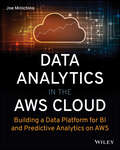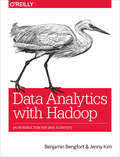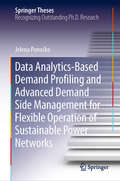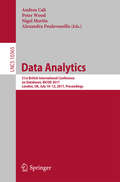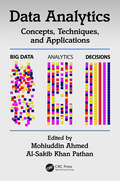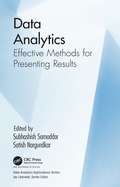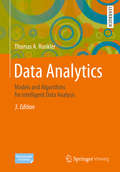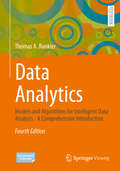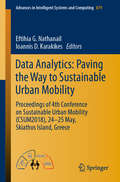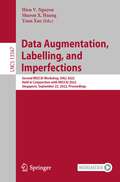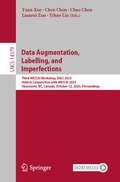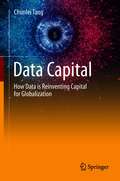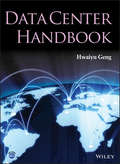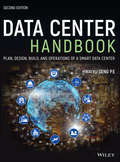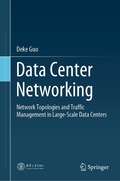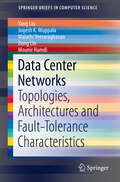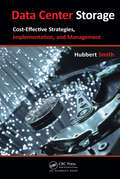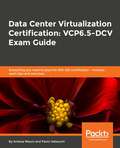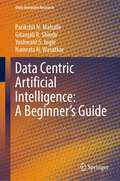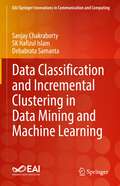- Table View
- List View
Data Analytics in the AWS Cloud: Building a Data Platform for BI and Predictive Analytics on AWS
by Joe MinichinoA comprehensive and accessible roadmap to performing data analytics in the AWS cloud In Data Analytics in the AWS Cloud: Building a Data Platform for BI and Predictive Analytics on AWS, accomplished software engineer and data architect Joe Minichino delivers an expert blueprint to storing, processing, analyzing data on the Amazon Web Services cloud platform. In the book, you’ll explore every relevant aspect of data analytics—from data engineering to analysis, business intelligence, DevOps, and MLOps—as you discover how to integrate machine learning predictions with analytics engines and visualization tools. You’ll also find: Real-world use cases of AWS architectures that demystify the applications of data analytics Accessible introductions to data acquisition, importation, storage, visualization, and reporting Expert insights into serverless data engineering and how to use it to reduce overhead and costs, improve stability, and simplify maintenanceA can't-miss for data architects, analysts, engineers and technical professionals, Data Analytics in the AWS Cloud will also earn a place on the bookshelves of business leaders seeking a better understanding of data analytics on the AWS cloud platform.
Data Analytics in the Era of the Industrial Internet of Things
by Aldo DagninoThis book presents the characteristics and benefits industrial organizations can reap from the Industrial Internet of Things (IIoT). These characteristics and benefits include enhanced competitiveness, increased proactive decision-making, improved creativity and innovation, augmented job creation, heightened agility to respond to continuously changing challenges, and intensified data-driven decision making. In a straightforward fashion, the book also helps readers understand complex concepts that are core to IIoT enterprises, such as Big Data, analytic architecture platforms, machine learning (ML) and data science algorithms, and the power of visualization to enrich the domains experts’ decision making. The book also guides the reader on how to think about ways to define new business paradigms that the IIoT facilitates, as well how to increase the probability of success in managing analytic projects that are the core engine of decision-making in the IIoT enterprise. The book starts by defining an IIoT enterprise and the framework used to efficiently operate. A description of the concepts of industrial analytics, which is a major engine for decision making in the IIoT enterprise, is provided. It then discusses how data and machine learning (ML) play an important role in increasing the competitiveness of industrial enterprises that operate using the IIoT technology and business concepts. Real world examples of data driven IIoT enterprises and various business models are presented and a discussion on how the use of ML and data science help address complex decision-making problems and generate new job opportunities. The book presents in an easy-to-understand manner how ML algorithms work and operate on data generated in the IIoT enterprise. Useful for any industry professional interested in advanced industrial software applications, including business managers and professionals interested in how data analytics can help industries and to develop innovative business solutions, as well as data and computer scientists who wish to bridge the analytics and computer science fields with the industrial world, and project managers interested in managing advanced analytic projects.
Data Analytics with Hadoop: An Introduction for Data Scientists
by Jenny Kim Benjamin BengfortReady to use statistical and machine-learning techniques across large data sets? This practical guide shows you why the Hadoop ecosystem is perfect for the job. Instead of deployment, operations, or software development usually associated with distributed computing, you’ll focus on particular analyses you can build, the data warehousing techniques that Hadoop provides, and higher order data workflows this framework can produce.Data scientists and analysts will learn how to perform a wide range of techniques, from writing MapReduce and Spark applications with Python to using advanced modeling and data management with Spark MLlib, Hive, and HBase. You’ll also learn about the analytical processes and data systems available to build and empower data products that can handle—and actually require—huge amounts of data.Understand core concepts behind Hadoop and cluster computingUse design patterns and parallel analytical algorithms to create distributed data analysis jobsLearn about data management, mining, and warehousing in a distributed context using Apache Hive and HBaseUse Sqoop and Apache Flume to ingest data from relational databasesProgram complex Hadoop and Spark applications with Apache Pig and Spark DataFramesPerform machine learning techniques such as classification, clustering, and collaborative filtering with Spark’s MLlib
Data Analytics-Based Demand Profiling and Advanced Demand Side Management for Flexible Operation of Sustainable Power Networks (Springer Theses)
by Jelena PonoćkoThis thesis deals with two important and very timely aspects of the future power system operation - assessment of demand flexibility and advanced demand side management (DSM) facilitating flexible and secure operation of the power network. It provides a clear and comprehensive literature review in these two areas and states precisely the original contributions of the research. The book first demonstrates the benefits of data mining for a reliable assessment of demand flexibility and its composition even with very limited observability of the end-users. It then illustrates the importance of accurate load modelling for efficient application of DSM and considers different criteria in designing DSM programme to achieve several objectives of the network performance simultaneously. Finally, it demonstrates the importance of considering realistic assumptions when planning and estimating the success of DSM programs.The findings presented here have both scientific and practical significance; they gained her BSc and MSc degrees in electrical engineering from the University of Belgrade in 2011 and 2012 respectively. She graduated with her PhD from the University of Manchester. She has presented at several conferences, and has won runner-up prizes in poster presentation at three. She has authored or co-authored more than 40 journal, conference and technical papers.provide a basis for further research, and can be used to guide future applications in industry.
Data Analytics: 31st British International Conference on Databases, BICOD 2017, London, UK, July 10–12, 2017, Proceedings (Lecture Notes in Computer Science #10365)
by Andrea Calì, Peter Wood, Nigel Martin and Alexandra PoulovassilisThis book constitutes the refereed conference proceedings of the 31st British International Conference on Databases, BICOD 2017 - formerly known as BNCOD (British National Conference on Databases) - held in London, UK, in July 2017.The 17 revised full papers were carefully reviewed and selected from numerous submissions. The papers cover a wide range of topics such as data cleansing, data integration, data wrangling, data mining and knowledge discovery, graph data and knowledge graphs, intelligent data analysis, approximate and flexible querying, data provenance and ontology-based data access. They are organized in the following topical sections: data wrangling and data integration; data analysis and data mining; graph data querying and analysis; multidimensional data and data quality; and distributed and multimedia data management.
Data Analytics: A Theoretical and Practical View from the EDISON Project
by Yuri Demchenko Juan J. Cuadrado-GallegoBuilding upon the knowledge introduced in The Data Science Framework, this book provides a comprehensive and detailed examination of each aspect of Data Analytics, both from a theoretical and practical standpoint. The book explains representative algorithms associated with different techniques, from their theoretical foundations to their implementation and use with software tools.Designed as a textbook for a Data Analytics Fundamentals course, it is divided into seven chapters to correspond with 16 weeks of lessons, including both theoretical and practical exercises. Each chapter is dedicated to a lesson, allowing readers to dive deep into each topic with detailed explanations and examples. Readers will learn the theoretical concepts and then immediately apply them to practical exercises to reinforce their knowledge. And in the lab sessions, readers will learn the ins and outs of the R environment and data science methodology to solve exercises with the R language. With detailed solutions provided for all examples and exercises, readers can use this book to study and master data analytics on their own. Whether you're a student, professional, or simply curious about data analytics, this book is a must-have for anyone looking to expand their knowledge in this exciting field.
Data Analytics: Concepts, Techniques, and Applications
by Al-Sakib Khan Pathan Mohiuddin AhmedLarge data sets arriving at every increasing speeds require a new set of efficient data analysis techniques. Data analytics are becoming an essential component for every organization and technologies such as health care, financial trading, Internet of Things, Smart Cities or Cyber Physical Systems. However, these diverse application domains give rise to new research challenges. In this context, the book provides a broad picture on the concepts, techniques, applications, and open research directions in this area. In addition, it serves as a single source of reference for acquiring the knowledge on emerging Big Data Analytics technologies.
Data Analytics: Effective Methods for Presenting Results (Data Analytics Applications)
by Subhashish Samaddar Satish NargundkarIf you are a manager who receives the results of any data analyst’s work to help with your decision-making, this book is for you. Anyone playing a role in the field of analytics can benefit from this book as well. In the two decades the editors of this book spent teaching and consulting in the field of analytics, they noticed a critical shortcoming in the communication abilities of many analytics professionals. Specifically, analysts have difficulty in articulating in business terms what their analyses showed and what actionable recommendations were made. When analysts made presentations, they tended to lapse into the technicalities of mathematical procedures, rather than focusing on the strategic and tactical impact and meaning of their work. As analytics has become more mainstream and widespread in organizations, this problem has grown more acute. Data Analytics: Effective Methods for Presenting Results tackles this issue. The editors have used their experience as presenters and audience members who have become lost during presentation. Over the years, they experimented with different ways of presenting analytics work to make a more compelling case to top managers. They have discovered tried and true methods for improving presentations, which they share. The book also presents insights from other analysts and managers who share their own experiences. It is truly a collection of experiences and insight from academics and professionals involved with analytics. The book is not a primer on how to draw the most beautiful charts and graphs or about how to perform any specific kind of analysis. Rather, it shares the experiences of professionals in various industries about how they present their analytics results effectively. They tell their stories on how to win over audiences. The book spans multiple functional areas within a business, and in some cases, it discusses how to adapt presentations to the needs of audiences at different levels of management.
Data Analytics: Models and Algorithms for Intelligent Data Analysis
by Thomas A. RunklerThis book is a comprehensive introduction to the methods and algorithms of modern data analytics. It provides a sound mathematical basis, discusses advantages and drawbacks of different approaches, and enables the reader to design and implement data analytics solutions for real-world applications. This book has been used for more than ten years in the Data Mining course at the Technical University of Munich. Much of the content is based on the results of industrial research and development projects at Siemens.
Data Analytics: Models and Algorithms for Intelligent Data Analysis - A Comprehensive Introduction
by Thomas A. RunklerThis book is a comprehensive introduction to the methods and algorithms of modern data analytics. It provides a sound mathematical basis, discusses advantages and drawbacks of different approaches, and enables the reader to design and implement data analytics solutions for real-world applications. The new edition integrates themes such as Word Embeddings, Transformer Models, and generative AI among the contents and offers new exercises in addition. This book has been used for more than ten years in the Data Mining course at the Technical University of Munich. Much of the content is based on the results of industrial research and development projects at Siemens.
Data Analytics: Proceedings Of 4th Conference On Sustainable Urban Mobility (csum2018), 24 - 25 May, Skiathos Island, Greece (Advances In Intelligent Systems and Computing #879)
by Eftihia G. Nathanail Ioannis D. KarakikesThis book aims at showing how big data sources and data analytics can play an important role in sustainable mobility. It is especially intended to provide academicians, researchers, practitioners and decision makers with a snapshot of methods that can be effectively used to improve urban mobility. The different chapters, which report on contributions presented at the 4th Conference on Sustainable Urban Mobility, held on May 24-25, 2018, in Skiathos Island, Greece, cover different thematic areas, such as social networks and traveler behavior, applications of big data technologies in transportation and analytics, transport infrastructure and traffic management, transportation modeling, vehicle emissions and environmental impacts, public transport and demand responsive systems, intermodal interchanges, smart city logistics systems, data security and associated legal aspects. They show in particular how to apply big data in improving urban mobility, discuss important challenges in developing and implementing analytics methods and provide the reader with an up-to-date review of the most representative research on data management techniques for enabling sustainable urban mobility
Data Assimilation for Atmospheric, Oceanic and Hydrologic Applications (Vol. II)
by Liang Xu Seon Ki ParkThis book contains the most recent progress in data assimilation in meteorology, oceanography and hydrology including land surface. It spans both theoretical and applicative aspects with various methodologies such as variational, Kalman filter, ensemble, Monte Carlo and artificial intelligence methods. Besides data assimilation, other important topics are also covered including targeting observation, sensitivity analysis, and parameter estimation. The book will be useful to individual researchers as well as graduate students for a reference in the field of data assimilation.
Data Assimilation for Atmospheric, Oceanic and Hydrologic Applications (Vol. IV)
by Liang Xu Seon Ki ParkThis book contains the most recent progress in data assimilation in meteorology, oceanography and hydrology including land surface. It spans both theoretical and applicative aspects with various methodologies such as variational, Kalman filter, ensemble, Monte Carlo and artificial intelligence methods. Besides data assimilation, other important topics are also covered including adaptive observations, sensitivity analysis, parameter estimation and AI applications. The book is useful to individual researchers as well as graduate students for a reference in the field of data assimilation.
Data Augmentation, Labelling, and Imperfections: Second MICCAI Workshop, DALI 2022, Held in Conjunction with MICCAI 2022, Singapore, September 22, 2022, Proceedings (Lecture Notes in Computer Science #13567)
by Hien V. Nguyen Yuan Xue Sharon X. HuangThis book constitutes the refereed proceedings of the Second MICCAI Workshop on Data Augmentation, Labelling, and Imperfections, DALI 2022, held in conjunction with MICCAI 2022, in Singapore in September 2022.DALI 2022 accepted 12 papers from the 22 submissions that were reviewed. The papers focus on rigorous study of medical data related to machine learning systems.
Data Augmentation, Labelling, and Imperfections: Third MICCAI Workshop, DALI 2023, Held in Conjunction with MICCAI 2023, Vancouver, BC, Canada, October 12, 2023, Proceedings (Lecture Notes in Computer Science #14379)
by Chen Chen Chao Chen Yuan Xue Lianrui Zuo Yihao LiuThis LNCS conference volume constitutes the proceedings of the 3rd International Workshop on Data Augmentation, Labeling, and Imperfections (DALI 2023), held on October 12, 2023, in Vancouver, Canada, in conjunction with the 26th International Conference on Medical Image Computing and Computer Assisted Intervention (MICCAI 2023). The 16 full papers together in this volume were carefully reviewed and selected from 23 submissions. The conference fosters a collaborative environment for addressing the critical challenges associated with medical data, particularly focusing on data, labeling, and dealing with data imperfections in the context of medical image analysis.
Data Capital: How Data is Reinventing Capital for Globalization
by Chunlei TangThis book defines and develops the concept of data capital. Using an interdisciplinary perspective, this book focuses on the key features of the data economy, systematically presenting the economic aspects of data science. The book (1) introduces an alternative interpretation on economists’ observation of which capital has changed radically since the twentieth century; (2) elaborates on the composition of data capital and it as a factor of production; (3) describes morphological changes in data capital that influence its accumulation and circulation; (4) explains the rise of data capital as an underappreciated cause of phenomena from data sovereign, economic inequality, to stagnating productivity; (5) discusses hopes and challenges for industrial circles, the government and academia when an intangible wealth brought by data (and information or knowledge as well); (6) proposes the development of criteria for measuring regulating data capital in the twenty-first century for regulatory purposes by looking at the prospects for data capital and possible impact on future society. Providing the first a thorough introduction to the theory of data as capital, this book will be useful for those studying economics, data science, and business, as well as those in the financial industry who own, control, or wish to work with data resources.
Data Center Handbook
by Hwaiyu GengData Center Handbook provides the fundamentals, technologies, and best practices in designing, constructing and managing mission critical, energy efficient data centers.* The most comprehensive single source guide ever published in this field, with 36 chapters and over 350 illustrations written by 50 world class authors* Offers disaster management techniques and lessons learned from 2011 earthquake and tsunami in Japan, and 2012 Superstorm Sandy* Discusses international standards and requirements, with contributions from experts in the United States, Canada, United Kingdom, France, Sweden, Japan, Korea, and China
Data Center Handbook: Plan, Design, Build, and Operations of a Smart Data Center
by Hwaiyu GengDATA CENTER HANDBOOK Written by 59 experts and reviewed by a seasoned technical advisory board, the Data Center Handbook is a thoroughly revised, one-stop resource that clearly explains the fundamentals, advanced technologies, and best practices used in planning, designing, building and operating a mission-critical, energy-efficient, sustainable data center. This handbook, in its second edition, covers anatomy, ecosystem and taxonomy of data centers that enable the Internet of Things and artificial intelligent ecosystems and encompass the following:SECTION 1: DATA CENTER OVERVIEW AND STRATEGIC PLANNINGMegatrends, the IoT, artificial intelligence, 5G network, cloud and edge computingStrategic planning forces, location plan, and capacity planning Green design & construction guidelines and best practicesEnergy demand, conservation, and sustainability strategiesData center financial analysis & risk managementSECTION 2: DATA CENTER TECHNOLOGIESSoftware-defined environmentComputing, storage, network resource managementWireless sensor networks in data centersASHRAE data center guidelinesData center telecommunication cabling, BICSI and TIA 942Rack-level and server-level coolingCorrosion and contamination controlEnergy saving technologies and server designMicrogrid and data centersSECTION 3: DATA CENTER DESIGN & CONSTRUCTIONData center site selectionArchitecture design: rack floor plan and facility layoutMechanical design and cooling technologiesElectrical design and UPSFire protectionStructural designReliability engineeringComputational fluid dynamicsProject managementSECTION 4: DATA CENTER OPERATIONS TECHNOLOGIESBenchmarking metrics and assessmentData center infrastructure managementData center air managementDisaster recovery and business continuity managementThe Data Center Handbook: Plan, Design, Build, and Operations of a Smart Data Center belongs on the bookshelves of any professionals who work in, with, or around a data center.
Data Center Networking: Network Topologies and Traffic Management in Large-Scale Data Centers
by Deke GuoThis book provides a comprehensive reference in large data center networking. It first summarizes the developing trend of DCNs, and reports four novel DCNs, including a switch-centric DCN, a modular DCN, a wireless DCN, and a hybrid DCN. Furthermore another important factor in DCN targets at managing and optimizing the network activity at the level of transfers to aggregate correlated data flows and thus directly to lower down the network traffic resulting from such data transfers. In particular, the book reports the in-network aggregation of incast transfer, shuffle transfer, uncertain incast transfer, and the cooperative scheduling of uncertain multicast transfer.
Data Center Networks: Topologies, Architectures and Fault-Tolerance Characteristics (SpringerBriefs in Computer Science)
by Yang Liu Jogesh K. Muppala Malathi Veeraraghavan Dong Lin Mounir HamdiThis SpringerBrief presents a survey of data center network designs and topologies and compares several properties in order to highlight their advantages and disadvantages. The brief also explores several routing protocols designed for these topologies and compares the basic algorithms to establish connections, the techniques used to gain better performance, and the mechanisms for fault-tolerance. Readers will be equipped to understand how current research on data center networks enables the design of future architectures that can improve performance and dependability of data centers. This concise brief is designed for researchers and practitioners working on data center networks, comparative topologies, fault tolerance routing, and data center management systems. The context provided and information on future directions will also prove valuable for students interested in these topics.
Data Center Storage: Cost-Effective Strategies, Implementation, and Management
by Hubbert SmithWe overspend on data center storage ... yet, we fall short of business requirements. It's not about the technologies. It's about the proper application of technologies to deliver storage services efficiently and affordably. It's about meeting business requirements dependent on data center storage. Spend less, deliver more. Data Center Storage: Cost-Effective Strategies, Implementation, and Management provides an industry insider's insight on how to properly scope, plan, evaluate, and implement storage technologies to maximize performance, capacity, reliability, and power savings. It provides business and use-case focused coverage of storage technology, including storage area networks (SAN), capacity-optimized drives, and solid-state drives. It offers key insights on financially responsible spending for data center storage. Delivered in accessible language, the book starts with a discussion of the business merits of replacing direct attached, compartmentalized storage with consolidated SAN-attached storage. The author advises on the use of service level applications (SLAs) as a tool to drive business unit collaboration with IT and prioritize those actions that impact productivity and profit from those that are less critical. This business guide to applied technologies disassembles big problems into digestible segments to help you understand, quantify, and fix any problems that arise as you work towards meeting your growing storage needs. The book builds on the consolidation and SLA driven approach to take advantage of the compelling benefits and potential savings of managed hosting and cloud storage.
Data Center Virtualization Certification: Everything you need to achieve 2V0-622 certification – with exam tips and exercises
by Andrea Mauro Paolo ValsecchiDeploy and configure vSphere infrastructure and learn to effectively create and administer vSphere virtual machinesKey FeaturesImplement advanced network virtualization techniquesConfigure and administer vSphere high availabilityEnhance your data center virtualization skills with practice questions and mock testsBook DescriptionThis exam guide enables you to install, configure, and manage the vSphere 6.5 infrastructure in all its components: vCenter Server, ESXi hosts, and virtual machines, while helping you to prepare for the industry standard certification.This data center book will assist you in automating administration tasks and enhancing your environment’s capabilities. You will begin with an introduction to all aspects related to security, networking, and storage in vSphere 6.5. Next, you will learn about resource management and understand how to back up and restore the vSphere 6.5 infrastructure. As you advance, you will also cover troubleshooting, deployment, availability, and virtual machine management. This is followed by two mock tests that will test your knowledge and challenge your understanding of all the topics included in the exam.By the end of this book, you will not only have learned about virtualization and its techniques, but you’ll also be prepared to pass the VCP6.5-DCV (2V0-622) exam.What you will learnDeploy and configure vSphere infrastructureCreate and administer vSphere virtual machinesOptimize, secure, and troubleshoot all vSphere componentsImplement vSphere HA on a vSAN clusterUnderstand how to back up and restore your vSphere 6.5 infrastructureTest your understanding of key concepts required through sample questionsWho this book is forIf you are interested in achieving Data Center Virtualization certification, this is the book is for you. You will also benefit from this book if you are a system administrator or network engineer. Some prior knowledge of virtualization can assist you in understanding key concepts covered in the book.
Data Centric Artificial Intelligence: A Beginner’s Guide (Data-Intensive Research)
by Parikshit N. Mahalle Gitanjali R. Shinde Yashwant S. Ingle Namrata N. WasatkarThis book discusses the best research roadmaps, strategies, and challenges in data-centric approach of artificial intelligence (AI) in various domains. It presents comparative studies of model-centric and data-centric AI. It also highlights different phases in data-centric approach and data-centric principles. The book presents prominent use cases of data-centric AI. It serves as a reference guide for researchers and practitioners in academia and industry.
Data Classification and Incremental Clustering in Data Mining and Machine Learning (EAI/Springer Innovations in Communication and Computing)
by Sk Hafizul Islam Debabrata Samanta Sanjay ChakrabortyThis book is a comprehensive, hands-on guide to the basics of data mining and machine learning with a special emphasis on supervised and unsupervised learning methods. The book lays stress on the new ways of thinking needed to master in machine learning based on the Python, R, and Java programming platforms. This book first provides an understanding of data mining, machine learning and their applications, giving special attention to classification and clustering techniques. The authors offer a discussion on data mining and machine learning techniques with case studies and examples. The book also describes the hands-on coding examples of some well-known supervised and unsupervised learning techniques using three different and popular coding platforms: R, Python, and Java. This book explains some of the most popular classification techniques (K-NN, Naïve Bayes, Decision tree, Random forest, Support vector machine etc,) along with the basic description of artificial neural network and deep neural network. The book is useful for professionals, students studying data mining and machine learning, and researchers in supervised and unsupervised learning techniques.
Data Classification: Algorithms and Applications (Chapman And Hall/crc Data Mining And Knowledge Discovery Ser. #35)
by Charu C. AggarwalComprehensive Coverage of the Entire Area of ClassificationResearch on the problem of classification tends to be fragmented across such areas as pattern recognition, database, data mining, and machine learning. Addressing the work of these different communities in a unified way, Data Classification: Algorithms and Applications explores the underlyi
